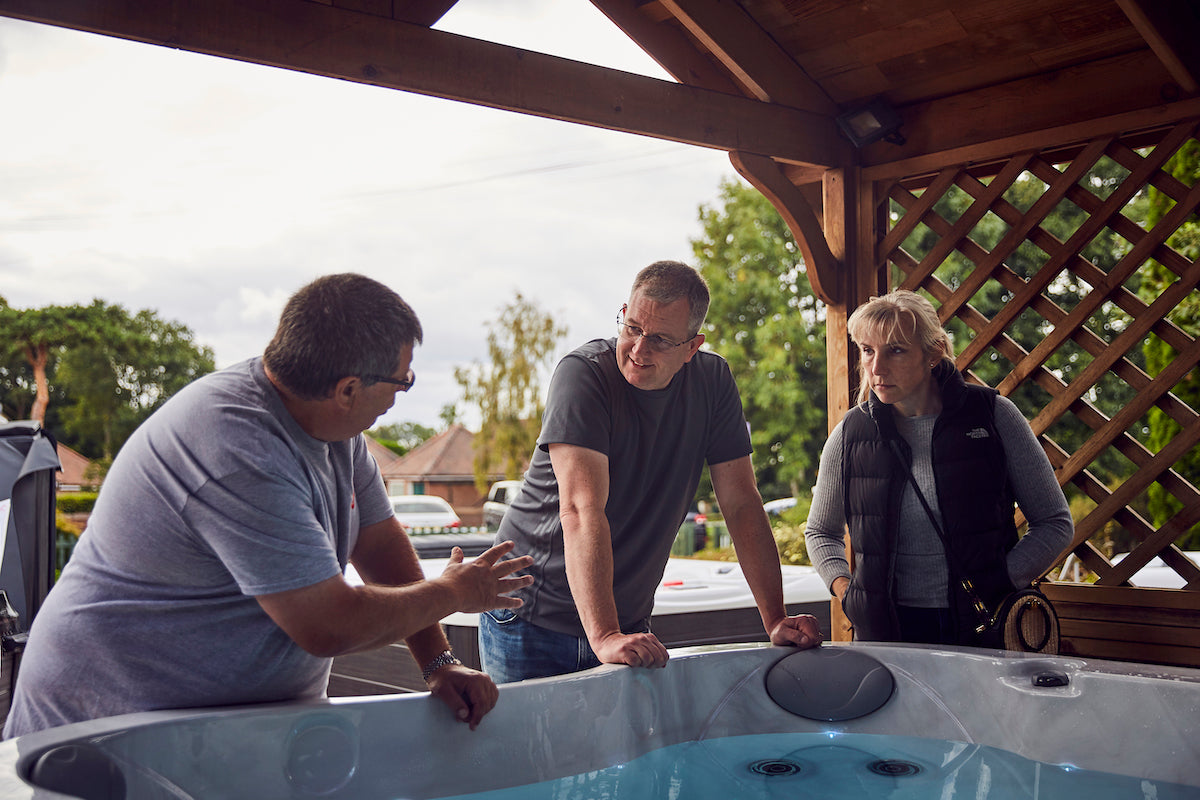Take the stress out of owning a hot tub with these quick and easy tips for keeping your hot tub water sparkling clean.
It is essential to maintain the cleanliness of your hot tub water, not only to keep the water looking clear and smelling fresh but also to eliminate the safety threat that unclean water can pose to you and your family.
We have put together some advice for clean and clear hot tub water, so follow these simple steps and you can sit back, relax and enjoy the bubbles without worrying about the cleanliness of the water.
Here are some of our top tips for maintaining clean and clear water in your hot tub:
- Regular water changes
- Clean filters
- Consistent levels sanitiser
- Balanced pH
- Shower before use
How to achieve consistently clean and clear hot tub water
Filtration and sanitisation are the fundamental essentials for keeping your hot tub water clean. However, there are further steps - such as regularly testing and changing the water - that you should take to ensure that your hot tub is safe to enjoy.
Testing your hot tub water
Your hot tub water needs regular testing to ensure that the water’s alkalinity, pH and sanitisers are all at safe levels.
All three can be checked using test strips which are readily available online and from hot tub stockists. It’s important to test your hot tub’s alkalinity first, as this result can skew your pH readings and give inaccurate results.
A healthy alkalinity reading will fall between 80 and 120 PPM. If alkalinity levels are too high, it prevents some disinfectants from working properly which can lead to cloudy water, skin and eye irritation, algae formation and scales along the sides and bottom of your hot tub.
If your alkalinity levels are too low, use an alkalinity increaser to boost the levels in your water.
Give your hot regular water changes
Remember to change your hot tub water every three months, as recommended by BISHTA (the British and Irish Spa and Hot Tub Association). This is to prevent chemical build-up as, after three months, the TDS (Total Dissolved Solids) can get high, resulting in reduced water clarity a greater amount of chemicals required than when your hot tub is freshly filled.
Take the opportunity to give your hot tub’s interior a clean while it’s empty. It’s also the perfect opportunity to clean out the plumbing and the filter, which should be done regularly to ensure that your hot tub continues to function efficiently.
When refilling your tub, be sure to place the garden hose into your hot tub’s filter compartment to prevent air pockets and filter the water as you fill.
Is water for your hot tub expensive?
Water prices can vary with location, but it shouldn’t be expensive to fill up your hot tub.
In the South West, 1m3 of water (1000 litres) is around £5, including an allowance for sewerage and surface water drainage - this means an average hot tub full is less than a pint and a packet of crisps at the pub.
Regular hot tub filtration
Movement of your hot tub water is essential to maintain its cleanliness - as with water in nature, it can become stagnant and unsafe to use without proper filtration.
Your hot tub pumps will work to keep your water fresh. Depending on the make and model of your tub, water will either be filtered through an individual circulation pump or through the jet pump at low speed. There are standard factory settings on all hot tubs that ensure the water is constantly filtering, keeping the water clean, warm and ready for use.
The water passes through filter elements that remove particle matter as small as five microns - that’s 14 times smaller than a human hair.
Hot tub sanitisation
It is essential to sanitise your hot tub water to eliminate any bacteria and viruses that thrive in warm water. These living organisms are so small that they’re invisible to the naked eye and are carried on your skin, so chlorine or bromine sanitisation is necessary to keep your hot tub water safe for you and your family.
Chlorine and bromine are the two most popular chemicals in the UK to treat hot tub water and kill off bacteria. Make sure that you run your chlorine at 3-5ppm or your bromine at 3-6ppm.
Chlorine is initially cheaper, easier to apply and works faster than bromine. However, bromine boasts some advantages over chlorine: although it costs slightly more, bromine works for longer and kills bacteria more effectively than chlorine, particularly at high temperatures and high pH levels.
It’s best to sanitise when you’ve finished bathing in your hot tub so that the water is fresh and clean before your next dip.
pH levels in your hot tub: what is it and why is it important?
In science terms, pH describes how acidic or basic a solution is. Whether an aqueous solution reacts as an acid or a base depends on its hydrogen ion (H+) content - in fact, the term ‘pH’ originates from Latin and is an acronym for potentia hydrogenii, meaning the power of hydrogen.
It’s important to check your pH levels using a testing strip before you add any sanitisers.
For your hot tub water, a pH of 7.2 is the goal. We aim for just above 7 to ensure that the water is ever so slightly base so that it will not corrode the pipework and fittings. Anything below 7.2 is too acidic, which may cause corrosion and eye irritation. pH levels above 7.8 are too alkaline, which puts your hot tub at risk of cloudy water, poor sanitiser efficiency and skin irritation.
To balance your pH levels, add the appropriate chemical - either a pH increaser or decreaser depending on the results of your testing strip.
Check out our aftercare plans to keep your hot tub in prime condition without the hassle.















